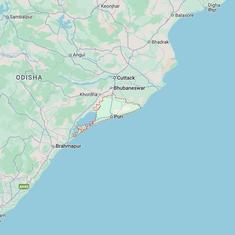On World Environment Day on June 5, a record 1.5 lakh saplings were planted in Chushul, a remote village in Ladakh, ostensibly to preserve and protect this high-altitude ecosystem. A similar plantation drive was undertaken in 2018 when 4,000 saplings were planted in the Leh region of Ladakh.
Such major plantation drives are often hailed as a one-stop solution to the country’s land degradation and environmental problems. However well-intended, they have not led to desired outcomes in many cases as they lack a scientifically-sound approach and misidentify the real problem.
On June 17, the World Day to Combat Desertification and Drought, it is important to remember that deserts are unique ecosystems.
Diverse geography
India is one of the world’s most biodiverse countries where every geographical region hosts a diversity of eco-climatic zones, which in turn nourish their own unique, ecosystems. The wettest parts of India have rainforests and cloud forests, the coastal zones have sand dunes, mangroves and coral reefs, and the central Indian plains support forests inhabited by tigers.
The driest parts of India – the mighty Thar desert in the west and the expansive high-altitude cold desert of the Tibetan plateau – also have ecosystems unique in structure, functionality, and the services they provide to their human inhabitants. They also have a host of species adapted to specific weather conditions.
India’s desert ecosystem has long been categorised as degraded, barren land. These ecosystems are then subject to interventions in the guise of habitat improvement and compensatory afforestation practices by planting non-native trees.

A tree species found in one part of India does not make it native to all ecosystems. This is why, even after decades of tree planting campaigns, India’s deserts continue to grapple with degradation and ecological annihilation. Deserts must be understood better to be able to fathom the scale of the effect plantation drives have on such ecosystems.
In India, deserts vary in structure and function, be it the saline desert of the Kutch landscape in Gujarat, the vast dunes of Rajasthan, or the cold desert of the Himalayas.
Each has been shaped by varying climatic and geological processes and support fauna and flora adapted to specific conditions. Half-baked interventions in such landscapes can have a cascading effect on biodiversity, which in turn affects the productivity of these ecosystems.
Ladakh’s cold desert
Take the case of Ladakh, a high-altitude, cold desert ecosystem characterised by bare, undulating mountains. Seasonal streams fed by glaciers limit the availability of water. The seemingly barren regions of these high-altitude areas support a range of unique biodiversity from the enigmatic snow leopard to the ibex and blue sheep.
Local human communities are also adapted to the extreme climate and depend upon livestock grazing and seasonal agriculture during spring for their livelihoods, with a recent shift towards tourism-based income.
Climate change has severely affected the socio-ecological environment of this landscape over the past decade. Rising temperatures have resulted in glaciers melting at a faster rate.
As the glaciers recede upwards, the timing and flow of seasonal streams is reduced, which results in an extended dry period during spring, which is when most locals prepare fields for sowing. This then leads to agricultural distress in a region already plagued with low productivity.
The case of the Kulum village near Leh is an indicator of the severity of this crisis. The entire village had to migrate due to severe water scarcity caused by the drying up of streams. Further, increasing and uncontrolled tourism puts additional strain on groundwater.
The aim to grow a mammoth forest – by planting 1.5 lakh saplings – in an area with an annual average rainfall of 100 mm, thin atmosphere and fragile soil substrate can have long-lasting ecological impacts such as soil degradation.
1,50,000 tree saplings planted on the occasion of #WorldEnvironmentDay at #Chushul in a mega plantation drive.
— DIPR Leh (@DIPR_Leh) June 6, 2022
H.H Chetsang Rinpoche @DrikungKyabgon conferred with the title 'Green Ambassador' of UT Ladakh@lg_ladakh @LAHDC_LEH@DC_Leh_Official @ddnewsladakh @airnewsalerts pic.twitter.com/Zf0mUTrkSm
It can also deplete groundwater tables further through increased evapo-transpiration, a process by which plants release water into the air.
Most of the areas targeted for plantation drives are outside of valleys and well above the natural tree line where climatic conditions are unsuitable for any tree to survive. Massive plantation drives, thus, fail to mitigate the climate concerns of the fragile Ladakh ecosystem.
Damaging grasslands
A similar negative outcome of such tree plantation activities was witnessed in the Banni grasslands of Kutch in Gujarat. Banni was among the finest tropical grasslands of Asia, but has seen its grass cover decrease over the past few decades.
The colonial view of deserts and grasslands as degraded landscapes prompted the extensive planting of the invasive prosopis juliflora – a small shrub-like tree – to control desertification and decrease soil salinity.
However, the prosopis juliflora has reduced local grass production by occupying more than half the landscape, converting it into a dense woodland. The shrinking grassland habitats have negatively affected the native wildlife as well as the livelihood of the Maldhari pastoralists.
A recent study by ATREE showed that the areas with a dense cover of invasive prosopis had a low water table and higher salinity than other areas.
Using the term desert as a synonym for degradation is an injustice to these unique landscapes around the world. Greening the desert is akin to degrading the desert. Not all brown is bad, and not all green is good.
Chetan Misher is an ecologist studying the dry grasslands of India and their associated wildlife. Current work involves understanding the impact of introduced invasive species on the native wildlife communities in these landscapes.
Abi Tamim Vanak is an animal ecologist and conservation biologist. His current work focuses on the ecology and conservation of India’s semi-arid savanna grasslands and its unique set of endemic and endangered fauna.
June 17 is observed as the World Day to Combat Desertification and Drought.










